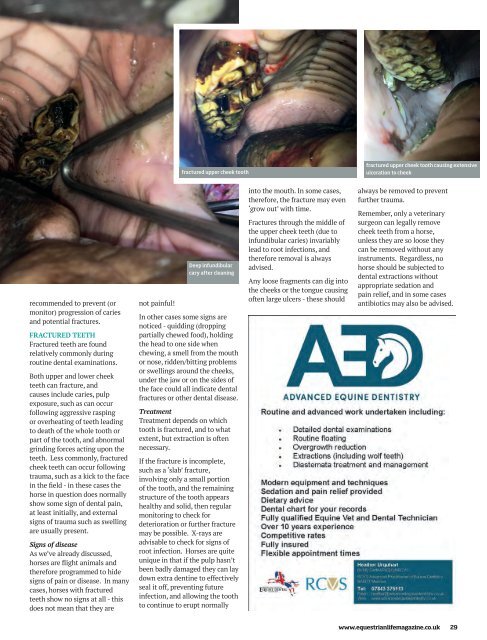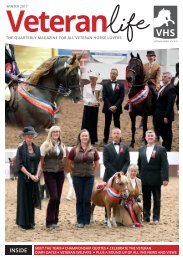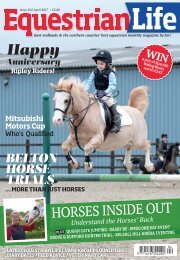Equestrian Life October 2017
The leading regional title for the East Midlands and Yorkshire
The leading regional title for the East Midlands and Yorkshire
Create successful ePaper yourself
Turn your PDF publications into a flip-book with our unique Google optimized e-Paper software.
fractured upper cheek tooth<br />
fractured upper cheek tooth causing extensive<br />
ulceration to cheek<br />
recommended to prevent (or<br />
monitor) progression of caries<br />
and potential fractures.<br />
FRACTURED TEETH<br />
Fractured teeth are found<br />
relatively commonly during<br />
routine dental examinations.<br />
Both upper and lower cheek<br />
teeth can fracture, and<br />
causes include caries, pulp<br />
exposure, such as can occur<br />
following aggressive rasping<br />
or overheating of teeth leading<br />
to death of the whole tooth or<br />
part of the tooth, and abnormal<br />
grinding forces acting upon the<br />
teeth. Less commonly, fractured<br />
cheek teeth can occur following<br />
trauma, such as a kick to the face<br />
in the field - in these cases the<br />
horse in question does normally<br />
show some sign of dental pain,<br />
at least initially, and external<br />
signs of trauma such as swelling<br />
are usually present.<br />
Signs of disease<br />
As we’ve already discussed,<br />
horses are flight animals and<br />
therefore programmed to hide<br />
signs of pain or disease. In many<br />
cases, horses with fractured<br />
teeth show no signs at all - this<br />
does not mean that they are<br />
not painful!<br />
Deep infundibular<br />
cary after cleaning<br />
In other cases some signs are<br />
noticed - quidding (dropping<br />
partially chewed food), holding<br />
the head to one side when<br />
chewing, a smell from the mouth<br />
or nose, ridden/bitting problems<br />
or swellings around the cheeks,<br />
under the jaw or on the sides of<br />
the face could all indicate dental<br />
fractures or other dental disease.<br />
Treatment<br />
Treatment depends on which<br />
tooth is fractured, and to what<br />
extent, but extraction is often<br />
necessary.<br />
If the fracture is incomplete,<br />
such as a ‘slab’ fracture,<br />
involving only a small portion<br />
of the tooth, and the remaining<br />
structure of the tooth appears<br />
healthy and solid, then regular<br />
monitoring to check for<br />
deterioration or further fracture<br />
may be possible. X-rays are<br />
advisable to check for signs of<br />
root infection. Horses are quite<br />
unique in that if the pulp hasn’t<br />
been badly damaged they can lay<br />
down extra dentine to effectively<br />
seal it off, preventing future<br />
infection, and allowing the tooth<br />
to continue to erupt normally<br />
into the mouth. In some cases,<br />
therefore, the fracture may even<br />
‘grow out’ with time.<br />
Fractures through the middle of<br />
the upper cheek teeth (due to<br />
infundibular caries) invariably<br />
lead to root infections, and<br />
therefore removal is always<br />
advised.<br />
Any loose fragments can dig into<br />
the cheeks or the tongue causing<br />
often large ulcers - these should<br />
always be removed to prevent<br />
further trauma.<br />
Remember, only a veterinary<br />
surgeon can legally remove<br />
cheek teeth from a horse,<br />
unless they are so loose they<br />
can be removed without any<br />
instruments. Regardless, no<br />
horse should be subjected to<br />
dental extractions without<br />
appropriate sedation and<br />
pain relief, and in some cases<br />
antibiotics may also be advised.<br />
www.equestrianlifemagazine.co.uk 29
















